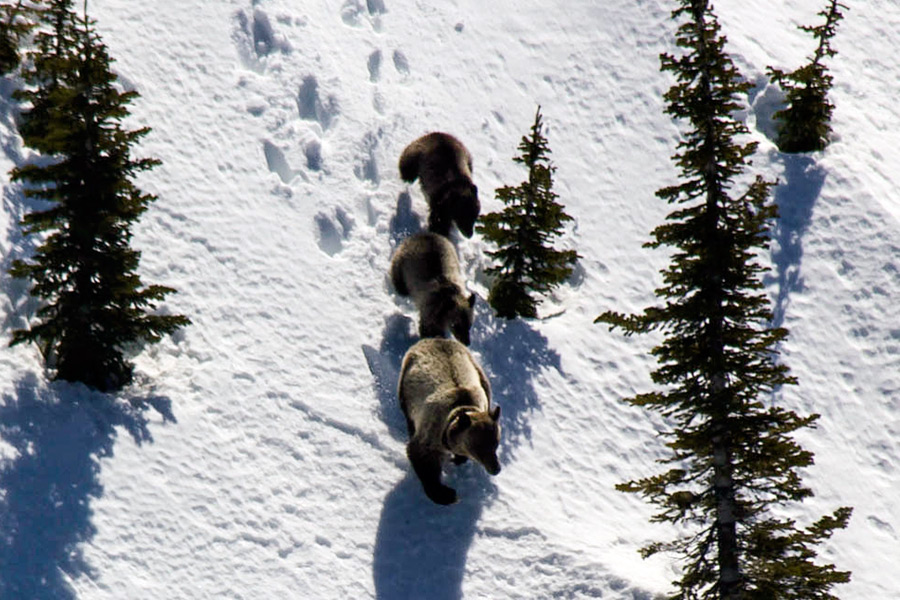With the arrival of spring, bears are beginning to emerge from their mountain dens and descend into the lower valleys in search of food, prompting wildlife officials to issue their perennial reminder for residents to be bear aware in an effort to reduce conflicts.
As local black bears and grizzlies begin to stir in the Flathead Valley, wildlife managers are anticipating an uptick in reports of bear sightings and conflicts with humans, a problem that can be dramatically reduced if residents remember to lock up pet food, birdseed, trash, and other food attractants.
“It is entirely avoidable if we start at the beginning of the season and make a conscious effort to secure these food attractants,” Erik Wenum, bear and lion specialist with the Montana Fish, Wildlife and Parks, said.
Bears gain confidence with each incremental learning experience in which they receive a positive food reward, and Wenum urged residents to take steps to avoid conflicts by reducing attractants.
He said the number-one conflict between bears and humans on the wildland-urban interface results from unsecured trash.
“That’s also the easiest to manage,” he said. “Bears are single-response learners. They figure it out the first time. This is a taught learning curve, and if they get a reward out of your trash can, it will happen again.”
Two years ago, a small black bear pried its way through a pet door and into a Whitefish home near Haskill Basin. The break-in occurred a day after the bear reached through the pet door to grab cat food, having been initially drawn to the back yard due to the presence of birdseed.
Although there haven’t been any reports of conflict, Wenum said there have been numerous sightings as grizzlies and black bears abandon their den after a long winter’s hibernation. Tracks spotted in the snows of Glacier National Park and the Whitefish Trail indicate that bears are venturing out in search of food.
Due to the region’s productive fall feeding period last year and a heavy winter snowpack, which helps bears conserve energy while they hibernate by keeping them warm in their dens, Wenum predicted that bruins would emerge bearing cubs and an above-average amount of fat.
Grizzly and black bears will soon begin roaming the Flathead Valley in greater abundance as they scour the valley floor for green, succulent vegetation to jumpstart their digestive tract.
“Bears are still pretty lethargic because their systems have been shut down for five or six months and it takes a while to get their gut going again,” Wenum said. “They’ll start out on dry grasses before they’re ready for the bigger items that will bring them into the river corridors and closer to town. We haven’t had any active conflicts yet, but unfortunately we are right around the corner.”
There are more than 1,000 grizzly bears in the Northern Continental Divide Ecosystem, an area encompassing the Flathead and Swan valleys. It’s the largest population of grizzlies in the lower 48 states.
In Whitefish, Wenum said several bears have been denning in town, including a female black bear and her cubs.
“It’s her home range, and bears return to their home range,” he said. “Even though you’re surrounded by neighbors on a city block, you’re still living in relatively occupied bear habitat.”
Most bears access town by traveling along river corridors, and in Whitefish those pathways typically lead them to the northwest part of town, along Wisconsin Avenue and Edgewood.
Beyond securing trash and other attractants, wildlife managers recommend bear-resistant bins in communities and on ranches; electric fence systems to protect chicken coops, bee yards and sheep bedding grounds; and random redistribution of livestock carcasses each spring.
Domestic chickens have been a particularly serious problem the past few years, according to wildlife managers.
If bears encounter birdseed — an ideal source of fat and protein — in a residential backyard, they’ll become increasingly adventuresome and comfortable around homes, Wenum said.
He encouraged anyone recreating on trail systems to carry bear spray.
“Bear spray works for everything — bears, lions, an angry moose,” he said. “It should be an essential item for recreating in bear country.”
FWP’s bear aware website at http://fwp.mt.gov/fishAndWildlife/livingWithWildlife/beBearAware/ provides homeowners and landowners with information about preventing bear conflicts.
Visit the site for tips and tools on obtaining and using bear spray, safe camping and hiking, access to bear-resistant produce and a guide to the many food-related and other items that attract bears to a property.
